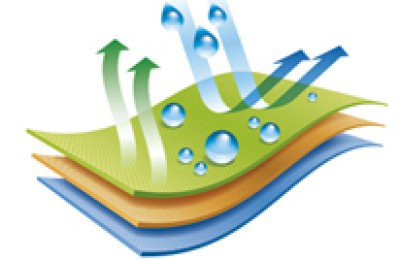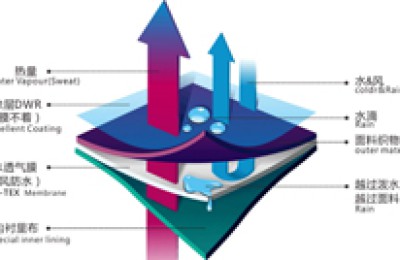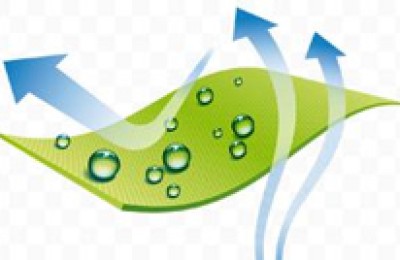High-strength nylon is difficult to dye into dark colors. Acid dyes and disperse dyes are mixed to dye high-strength nylon. The mixed dye dyeing process recipe: dyeing temperature 130℃, dyeing time 60min, pH value 5-6. The results show that the apparent color depth of the fabric is significantly higher than that dyed with acid dyes or disperse dyes alone. Acid dyes have a stable structure at high temperatures and have excellent fastnesses.
Preface
Nylon is currently dyed with acid dyes, disperse dyes, neutral dyes and reactive dyes. When dyeing with weakly acidic and reactive dyes, the dye molecules combine with the “dye seat” of the nylon fiber molecules to dye, but the “dye seat” is limited, and generally only medium and light colors can be dyed; when dyeing with disperse dyes, the thermoplasticity of synthetic fibers is used to The movement of fiber molecular chains intensifies under high temperature conditions, and the dye diffuses into the interior of the fiber and is adsorbed and fixed. Disperse dyes are special dyes for polyester. The color yield of nylon is not high, and it can only dye light colors, so nylon is not easy to dye dark colors. High-strength nylon fiber molecules have higher crystallinity and orientation, making it less likely to be dyed darkly during dyeing.
This article uses a mixed dyeing method of weak acid dyes and disperse dyes to significantly improve the problem of high-strength nylon dyeing in dark colors, obtain feasible process conditions, and see significant results, providing a solution to this problem. Effective solution route.
Experimental part
1. Experimental materials and instruments
Material: high-strength nylon filament fabric (500D nylon 66 gray cloth), Weakly acidic black BR, weakly acidic red GN, weakly acidic yellow GN, weakly acidic brilliant blue RAWL (Shanghai Jiaying Chemical Co., Ltd.), Anoclon dispersed black PUD, Anoclon dispersed red PUD, Anoclon dispersed Yellow PUD, Anoklon dispersed blue PUD (Anoqi Dyes Co., Ltd.), etc.
Instruments: SF600 computer color measurement and matching instrument (Datacolor Company of the United States), UV-2600 visible light spectrophotometer [Unico (Shanghai) Instrument Co., Ltd.].
2. Dyeing process and prescription
2.1 Acid dye dyeing process
To dye high-strength nylon with weak acid dye, the process prescription is: The dye dosage is Wash in water, cold water and tumble dry.
2.2 Disperse dye dyeing process
To dye high-strength nylon with disperse dye, the process prescription is: dye dosage is Y% (o.w.f), dispersant M2g/l, pH value 5- 6. Liquor ratio 1:50, dyeing at room temperature, heating rate 2℃/min, dyeing at 130℃ for 60min, reduction cleaning, water washing and drying after dyeing.
2.3 Mixed dyeing process of acidic and disperse dyes
Process prescription:
Dyeing curve (omitted)
3. Test method
3.1 Determination of dye uptake rate
Use UV-2600 spectrometer A photometer was used to measure the absorbance of the original solution and residual solution.
3.2 Determination of K/S value
Use the SF600 computer color measurement and matching instrument to determine the K/S value of the dyed sample according to the instrument operating procedures.
3.3 Determination of color fastness
The color fastness to soaping is in accordance with GB/T 3921-2008 “Textiles Color Fastness Testing Color Fastness to Soaping” Fastness to rubbing” standard test;
Color fastness to rubbing is tested according to GB/T 3920-2008 “Color Fastness to Rubbing Test for Color Fastness of Textiles” standard test;
Color fastness to washing The fastness is tested according to the standard GB/T 420-2009 “Testing on Color Fastness of Textiles – Color Fastness to Scrubbing”;
The color fastness to perspiration is tested according to GB/T 3922-2013 “Color Fastness to Textiles to Perspiration” Test Methods” Standard Test.
Results and analysis
1. Single application type dyeing
Select weakly acidic black BR and Anoclon dispersed black For PUD dyes, dye liquors with different dye dosages are prepared and dyed using the dyeing processes in 1.2.1 and 1.2.2 respectively. The results of testing the K/S value of the dyed fabrics using the method 1.3.2 are shown in Figure 1.
Figure 1 Study on the improvement of high-strength nylon dyed with dyes
With the increase in dye usage, The apparent color depth K/S value of high-strength nylon gradually increases until it reaches equilibrium. When the concentration of weakly acidic black BR is 3% (o.w.f), the K/S value is 23.88; when the dosage of Anoklon dispersed black PUD dye is 6% (o.w.f), the K/S value is 16.70, and the high-strength nylon The color yield of the fabric no longer increases significantly, and the dyeing saturation value is reached at this time, but it obviously does not meet the requirements for deep dyeing.
2. Study on the mixed dyeing of two dyes
2.1 Study on the dyeing depth of mixed dyeing of two dyes
Select weak acid black BR and Anoclon dispersed black PUD are mixed according to the dye dosage (o.w.f) of 2%/2%, 3%/3%, 4%/4%, 5%/5% and 6%/6% respectively. The dyes were mixed and dyed according to the dyeing process 1.2.3, and the effects of different dye dosages on the dyeing percentage and K/S value were tested. The results are shown in Figure 2.
Figure 2 The impact of different dye dosages on the dyeing percentage and K/S value during mixed dyeing
As shown in Figure 2, keeping the ratio of the two dyes in mixed dyeing unchanged, as the amount of dye increases, the apparent color depth of high-strength nylon mixed-dyed with weakly acidic black BR and Anoclon dispersed black PUD changes. When the dosage is 5%/5% (o.w.f), the color yield of the fabric is the highest. Maintain total dye usage�� is unchanged at l0% (o.w.f), and the weakly acidic black BR and Anoclon dispersion black PUD are 2%/8%, 4%/6%, 5%/5%, 6%/4%, 8 respectively. %/2% dye dosage (o.w.f) was mixed for dyeing, and the effects of different proportions of dye dosage on the dyeing percentage and K/S value were tested (Figure 3).
Figure 3 Effects of different proportions of dye dosage on dyeing percentage and K/S value
From As can be seen from Figure 3, when the mixed dye of weakly acidic black BR dye and Anoclon dispersed black PUD is used to dye high-strength nylon, the total amount of dye remains unchanged, the dyeing percentage and apparent color depth change, and the dye amount is 5 When %/5%, the dyeing percentage is the highest and the color yield of the fabric is the best. It is recommended that when dyeing high-strength nylon with two dyes, the dye dosage should be controlled to 5%/5% (o.w.f).
2.2 Single dyeing and mixed dyeing effects of dyes
Comparison of total dye dosage is 10% (o.w.f), weak acid black BR single dyeing, Annuo The color indicators of Shangqiang nylon fabric dyed with Colon dispersed black PUD and acid black BR and Anoklon dispersed black PUD mixed with each other are shown in Table 1 and Figure 4.
Table 1 compares the L, a, b, C, h values of fabrics dyed with different dyes
The lightness value L of black fabric is low, a, b The smaller the value, the lower the chroma value C. As shown in Table 1, keeping the total amount of dyes unchanged at 10% (o.w.f), disperse black dyed fabrics are far from black, with serious red light, acid black dyed fabrics are navy blue, and mixed dye dyed fabrics have lightness The value L is the lowest and the chroma value C is the lowest, which is pure black.
2.3 Structural stability of weakly acidic dyes during high-temperature and high-pressure dyeing
Dyeing with weakly acidic dyes is generally carried out in boiling dyeing, and the dye stability is unquestionable, but 130 The structural stability of ℃ dyeing has not been clearly reported. Perform performance tests under high temperature and high pressure conditions, as shown in Figure 5, the weak acid black BR and the three primary colors weak acid red GN, weak acid yellow GN, and weak acid brilliant blue RAWL are dyed according to the dyeing process 1.2.1, the temperature is 130°C , the dye dosage is 4% (o.w.f), no fabric is added, and the absorbance spectral images before and after dyeing are measured.
Figure 4 Absorbance spectrum image of acid dye
As can be seen from Figure 4, under high temperature and high pressure of 130℃ After dyeing for 60 minutes, the absorption spectral curves of weakly acidic black BR and the three primary colors weakly acidic red GN, weakly acidic yellow GN, and weakly acidic brilliant blue RAWL remain unchanged, indicating that under these conditions, the molecular structure of the dye is stable, and the weakly acidic dye is stable at 130°C. There is no obstacle to staining.
2.4 Fastness of dyed fabrics
Test weak acid black BR and Anoclon dispersion black PUD according to the method 1.3.3 (dye dosage is 5% /5%) mixed dyeing of high-strength nylon color fastness to soaping, rubbing, brushing and perspiration. The results are shown in Table 2.
Table 2 Dye fastness of high-strength nylon dyed by mixing two dyes
The results show that various dyeing methods of fabrics dyed with mixed dyes Good fastness.
Conclusion
High-strength nylon is dyed with mixed dyes of weakly acidic black BR and Anoclon dispersed black PUD. The dyeing process is: the dye dosage is 5 %/5% (o.w.f), dyeing temperature 130℃, dyeing time 60min, pH value 5-6. Pure black can be obtained. The K/S value of the apparent color yield of the fabric is 26.52. The color fastness to soaping, rubbing fastness, scrubbing fastness, acid and alkali perspiration fastness can all reach level 4 and above. level. The acid dye structure is stable under these dyeing conditions. This solution is a good solution to the problem of dark dyeing of high-strength nylon fabrics of various colors, and is also a feasible solution for dyeing nylon in dark colors.
</p





